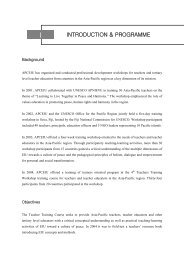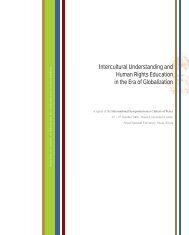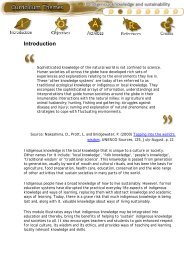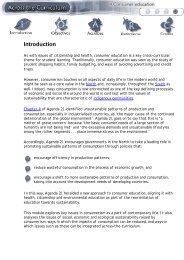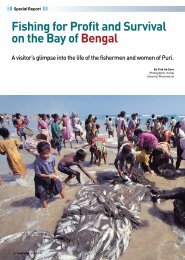REPORT OF UNESCO EXPERT MEETING ON - APCEIU
REPORT OF UNESCO EXPERT MEETING ON - APCEIU
REPORT OF UNESCO EXPERT MEETING ON - APCEIU
Create successful ePaper yourself
Turn your PDF publications into a flip-book with our unique Google optimized e-Paper software.
However what goes as "environmental economics' or "resource economics" are both, at best, sub-fields of<br />
neoclassical economics. To that extent, whether it be in valuing the natural resources or dealing with the<br />
externalities of pollution and waste, there is always a talk about "internalising environmental costs". But<br />
then the question would be, how would this “internalisation of environmental costs” be done, under<br />
globalisation and in a globalising world which undermines the ability of nations to internalise environmental<br />
and social costs. When economic integration, powered by free market economics, promotes a race to the<br />
bottom, what Amartya Sen calls welfare cutting competition, in terms of the lowest common denominator in<br />
social and environmental standards.<br />
In such a situation, internalising environmental costs can be a pipe dream. It may have to more to do with<br />
what some harsh critics of environment economics, refer to as the cosy, enchanted theoretical world of an<br />
emerging class of "environmental economists" cut off from the social realities of poverty and hunger. Quite<br />
aside of the social problems, even in ecological terms, what poses as environmental economics is seen by<br />
some economists as inadequate to the challenges faced by the Earth’s ecosystem, and in response new fields<br />
as ecological economics has also emerged.<br />
3. Economics, Economists, Sources and Sinks<br />
While economists of different hues and economic theories can always summon this or that evidence to<br />
support one or the other argument, for or against the environment, the fact is that science has fairly settled<br />
the issue and a paradigm shift has taken place. In 1972, when the Club of Rome made public its famous<br />
`Limits to Growth' thesis, positing limits to economic growth in terms of scarcity of resources, resource<br />
economists and others showed the fallacies involved and how resource limits could be overcome. However,<br />
the real paradigm shift had to be made in relation to nature as a sink; especially, the atmosphere as a sink<br />
absorbing globe-warming and ozone-depleting gases, when it was realised that while resource limits could<br />
be overcome, sink limits were absolute. The natural ecosystem, including the atmosphere, had absolute<br />
limits as to how much of the wastes of economic growth it could take as a sink. This leaves us with no other<br />
choice but to address the central problem and deal with the scale of our "growth", "the physical size of the<br />
economy relative to the containing ecosystem", as the eminent ecological economist Herman Daly has put<br />
it, thus beautifully capturing the relationship of the economy to nature and the dilemma we are in.<br />
This central fact that even if resource limits may be overcome, sink limits are absolute is the most<br />
significant contribution from environmental and ecological perspective to achieving sustainable<br />
development. In paradigmatic terms, this shift in our understanding of our relationship to “the containing<br />
ecosystem” is comparable to the shift in the world view of physics from Newtonian physics to Einsteinian<br />
physics. One need not go into a whole lot of environment perspectives in looking at the arguments for<br />
sustainable development. The fact that we may reach and breach sink limits leading to may be irreversible<br />
consequences is a powerful perspective for humanity to reconsider all that humanity especially in this<br />
century has taken for granted.<br />
This is the main reason that even powerful institutions such as the World Bank which has for the past three<br />
decades or more, in almost evangelical terms, been propagating the belief that rapid economic growth is the<br />
only panacea, is beginning to realise the illogic of such a position. In earlier times when the Bank did<br />
address the issue of `Environment and Development' (the 1992 World Development Report was on this<br />
theme), it was only to argue that more economic growth was the automatic solution to environmental<br />
problems.<br />
In the WDR of 1992, World Bank economists even discovered an "environmental Kuznets curve", whereby<br />
they could argue that though growth was initially bad for the environment, persisting with growth was<br />
necessary because it would be good for the environment later. Though it did not exactly happen that way<br />
and which anyway was to be expected. This, in spite of the power, the seduction and propaganda blitz<br />
involved in the story telling through the WDRs by the World Bank economists. This is also why it still took<br />
the World Bank, almost a decade to change its story line. The World Bank finally did catch up on the<br />
distinction between "sources" and "sinks", in the WDR 2003, `Sustainable Development in a Dynamic<br />
World'.<br />
49



